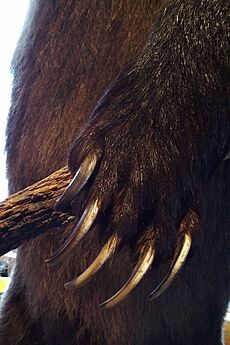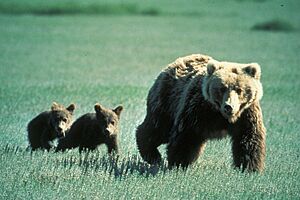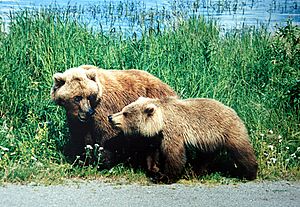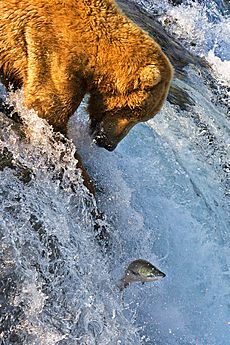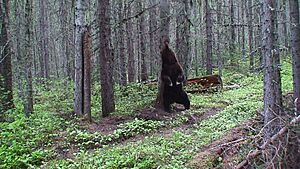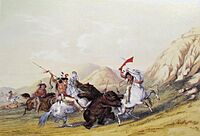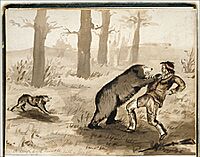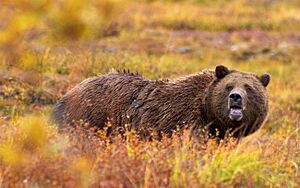Grizzly bear facts for kids
Quick facts for kids Grizzly bearTemporal range:
Late Pleistocene – present (~45,000–0 YBP)
|
|
|---|---|
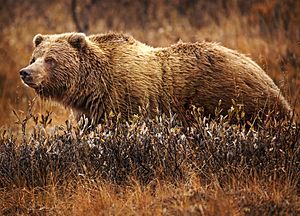 |
|
| Conservation status | |
| Scientific classification |
|
| Kingdom: | Animalia |
| Phylum: | Chordata |
| Class: | Mammalia |
| Order: | Carnivora |
| Family: | Ursidae |
| Genus: | Ursus |
| Species: | |
| Subspecies: |
U. a. horribilis
|
| Trinomial name | |
| Ursus arctos horribilis (Ord, 1815)
|
|
| Possibly synonymous subspecies | |
|
|
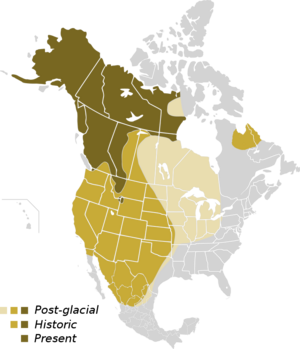 |
|
| Historic and present range | |
The grizzly bear (scientific name: Ursus arctos horribilis) is a famous type of brown bear found in North America. People also call it the North American brown bear or just grizzly. These powerful animals are known for their strength and wild beauty. While Ursus arctos horribilis is the main grizzly, other brown bears in North America are sometimes called grizzlies too, like the huge Kodiak bear. Generally, grizzlies living near the coast are bigger than those living inland.
Contents
Grizzly Bears: North America's Mighty Brown Bears
How Grizzlies Got Their Name
The explorers Meriwether Lewis and William Clark first called these bears "grisley." This word could mean "grizzled," referring to their hair often having grey tips. It could also mean "fear-inspiring." Today, we use "grizzly" for their grey-tipped fur.
The Grizzly Family Tree
Scientists have studied grizzly bear genetics. They found that all brown bears, including grizzlies, are closely related. Brown bears first came to North America from Eurasia thousands of years ago. Modern genetic testing shows the grizzly bear is a subspecies of the wider brown bear family (Ursus arctos). Coastal grizzlies, like the Kodiak bear, are often bigger and darker than inland grizzlies, usually due to more food.
Appearance and Size
How Big Are Grizzlies?
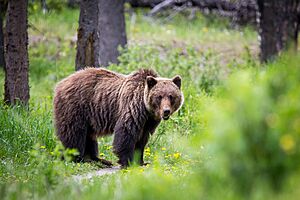
Grizzly bears are among the largest types of brown bears. Their size changes depending on where they live. Coastal grizzlies in Alaska are the biggest. Males can weigh around 389 kilograms (858 pounds), and females about 207 kilograms (456 pounds). Inland grizzlies are smaller. An adult grizzly can be between 198 cm and 240 cm (6.5 to 7.9 feet) long. Newborn cubs are tiny, less than 500 grams (1 pound).
Special Features of a Grizzly
Grizzly bear fur comes in many colors, from light blonde to almost black. It is often brown with darker legs and white or blonde tips. You can tell grizzlies apart from American black bears:
- Grizzlies have a noticeable muscular hump on their shoulders.
- A grizzly's face often looks "dished in" with short, rounded ears.
- Grizzly front claws are long (5 to 10 cm), good for digging.
Where Do Grizzlies Live?
Grizzly Homes Across North America
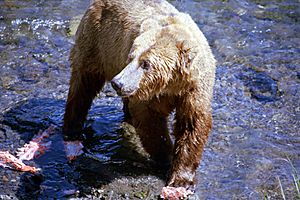
Grizzly bears once lived across a much larger area of North America. Today, they are mainly found in Alaska, western Canada, and parts of the northwestern United States, including Yellowstone National Park. Their numbers have dropped due to hunting and losing their natural homes.
How Many Grizzlies Are There?
About 60,000 wild grizzly bears live in North America. Around 30,000 are in Alaska, which has the largest population. In the lower 48 United States, there are fewer grizzlies. About 1,000 live in northwestern Montana, and another 1,000 in the Greater Yellowstone Ecosystem.
Lost Homes and Recovery Efforts
Grizzly bears have disappeared from many areas, like the Great Plains. The California grizzly bear is now extinct. Today, grizzlies are legally protected in Mexico, parts of Canada, and all of the United States. Bringing them back to their old homes is a slow process.
Grizzly Bear Life Cycle
Winter Sleep: Hibernation
Grizzly bears spend five to seven months each year in hibernation. Before hibernating, they eat a lot to gain weight and build a cozy den. During hibernation, bears don't eat or drink. Female grizzlies give birth to tiny cubs, who drink their mother's milk. Males wake in March, females with cubs in April or May.
Raising Cubs: Reproduction
Grizzlies usually live alone, except for mothers with cubs. Females, called sows, usually have two tiny cubs. Mothers are very protective and will defend their cubs fiercely. Grizzly bears reproduce slowly. Females don't have cubs until they are at least five years old. A mother cares for her cubs for up to two years.
How Long Do Grizzlies Live?
Male grizzlies usually live for about 22 years in the wild. Females live a bit longer, around 26 years. The oldest wild grizzly known lived to be 39 years old.
How Fast Can Grizzlies Move?
Grizzlies are surprisingly fast! They can run up to 48 km/h (30 mph). They can also climb trees, especially when young.
What Do Grizzlies Eat?
An Omnivore's Diet
Grizzly bears are omnivores, eating both plants and animals. Their diet changes with the seasons. They hunt large mammals like moose and elk, especially young or weak ones. Grizzlies also love fish, like salmon. Coastal grizzlies, with more fish, grow much larger. They also find food left by other animals. Plants are a huge part of their diet, sometimes 80-90%. They enjoy many kinds of berries, roots, and grasses. In Yellowstone National Park, they eat pine nuts and even moths. Grizzlies dig for small animals like ground squirrels. They might hunt bison or moose, but are careful. Sometimes, they scavenge on dead whales or seals.
Grizzlies and Other Animals
Grizzly bears are powerful. They often get their way when it comes to food, sometimes taking kills from other predators like wolves or cougars. Black bears typically avoid grizzly territory. Sometimes, grizzlies and polar bears meet, and can even have cubs together, creating a grizzly–polar bear hybrid.
Grizzlies' Role in Nature
Grizzly bears play a very important role in their environment. They help spread seeds from fruits, helping new plants grow. When they dig for food, they stir up the soil, which helps different plants grow and brings nutrients to the surface. Grizzlies also bring nutrients from salmon into forests. They are a "keystone predator," meaning they have a big impact on their ecosystem. By hunting, they help keep prey populations healthy.
Grizzlies and People
Native American Connections
Native American tribes have long lived alongside grizzly bears. They felt both deep respect and fear for these powerful animals. Many stories and legends feature the grizzly bear, like the Ojibwe legend behind Sleeping Bear Dunes National Lakeshore.
Staying Safe Around Grizzlies
Grizzlies are defensive, especially when protecting cubs or food. Mothers with cubs are most likely to attack. Grizzly bears generally avoid people and rarely hunt humans. Most dangerous encounters happen when a bear is surprised at close range, or protecting food or cubs.

"Problem bears" get used to finding food near human areas. To prevent this, communities teach people to manage food and garbage safely. Keep trash secure and store pet food indoors. If hiking or camping, make noise to avoid surprising a bear. Store food in bear-proof containers or hang it high. Hiking in groups can also make you safer.
Watching Grizzlies Safely
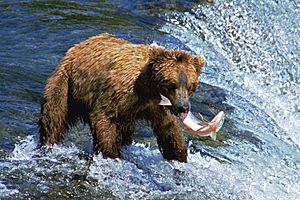
Many people travel to Alaska to watch grizzly bears. This ecotourism is popular. Some of the best places are along the Alaska Peninsula coast, where bears gather to eat salmon, clams, and berries. Katmai National Park and Preserve is a top spot. At Brooks Camp, you can watch grizzlies catch salmon from platforms, or even online.
Protecting Grizzly Bears
Why Grizzlies Need Protection
Grizzly bears are an endangered or threatened species in many areas. In the United States, they are listed as threatened. In parts of Canada, they are endangered. National parks in both the U.S. and Canada have rules to protect these bears.
Working to Save Grizzlies
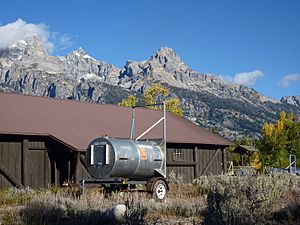
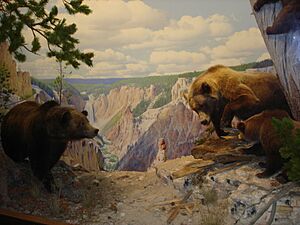
Many groups work to protect grizzly bears. Creating national parks and protected areas is a key strategy, like the Khutzeymateen Grizzly Bear Sanctuary in British Columbia. This sanctuary has strict rules against hunting. Other efforts focus on educating people. Urban areas and roads can block bears from moving freely. Conservation plans include "wildlife corridors," like tunnels or overpasses, for bears to cross roads safely. Scientists use GPS tracking to study these efforts. In the United States, the Interagency Grizzly Bear Recovery Committee helps grizzlies in the lower 48 states. In 2017, a plan was released to help grizzlies return to the North Cascades region. This shows ongoing efforts to balance human activities with wildlife protection.



